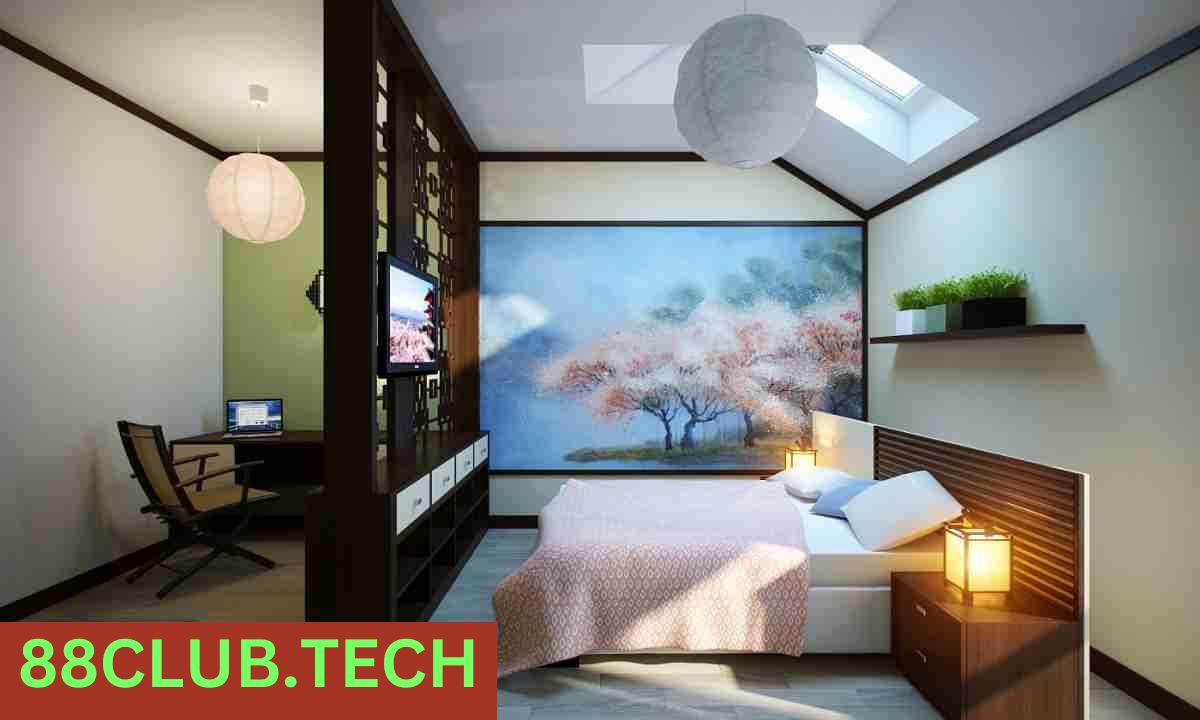Designing a minimalist Japanese style bedroom is more than just an exercise in aesthetics it’s about cultivating a tranquil sanctuary where simplicity reigns. This guide provides a comprehensive roadmap to creating a serene, harmonious space infused with traditional Japanese design principles and modern functionality.
Understanding Japanese Minimalism and Zen Philosophy
The Zen Philosophy in Japanese Interior Design
Japanese minimalism draws heavily from Zen philosophy, a spiritual and aesthetic practice that values simplicity, mindfulness, and balance. The essence of Zen in design is not just about creating visually pleasing spaces but also about fostering a deep sense of calm and inner peace.
- Ma: This concept refers to the space between objects and the importance of emptiness. In Japanese design, Ma is as crucial as the items within a space. It allows for breathing room, visually resting the eyes and mind.
- Wabi-Sabi: Acknowledging and embracing imperfection and transience is central to this principle. Wabi-Sabi celebrates the beauty of things that are imperfect, impermanent, and incomplete.
Incorporating these principles into your minimalist Japanese style bedroom will help you create a space that feels as good as it looks, promoting a serene atmosphere conducive to relaxation and reflection.
Core Elements of a Minimalist Japanese Bedroom

Tatami Mats: The Foundation of Traditional Japanese Design
Tatami mats are a cornerstone of traditional Japanese interiors and play a significant role in the minimalist Japanese style bedroom.
Benefits of Tatami Mats:
- Comfort: Tatami mats provide a soft, supportive surface that enhances comfort, making them ideal for sitting and sleeping.
- Insulation: They help with temperature regulation and moisture absorption, contributing to a comfortable living environment.
- Aesthetics: The natural texture of Tatami mats adds warmth and a sense of connection to nature.
Tatami Mats vs. Western Flooring Options:
| Feature | Tatami Mats | Western Flooring |
| Material | Natural rush grass | Wood, carpet, etc. |
| Comfort | High | Varies |
| Insulation | Good | Varies |
| Maintenance | Low | Varies |
Tatami mats not only define the space but also set the stage for the rest of your minimalist design.
Futon vs. Low Platform Beds
When it comes to sleeping arrangements in a minimalist Japanese style bedroom, you have two main options: futons and low platform beds.
- Futons: These are traditional Japanese bedding laid directly on the floor. They are rolled up and stored away during the day, which helps keep the space open and uncluttered.
- Pros: Space-saving, easy to store, aligns with traditional Japanese design.
- Cons: Requires daily setup and takedown, might not provide as much support as a mattress on a platform bed.
- Low Platform Beds: These beds are designed to be close to the ground, mirroring the aesthetic of traditional Japanese sleeping arrangements while offering more permanent support.
- Pros: Provides consistent comfort, fits well with a minimalist aesthetic.
- Cons: Takes up more space, requires a dedicated sleeping area.
Shoji Screens: Privacy with Elegance
Shoji screens are integral to Japanese interiors, offering both functionality and aesthetic appeal. These sliding partitions are made from wooden frames and translucent paper, allowing light to filter through softly.
Benefits of Shoji Screens:
- Soft Lighting: They create a warm, diffused light that enhances the room’s tranquility.
- Flexibility: Can be used to divide spaces or offer privacy without the bulk of traditional walls.
- Aesthetic Appeal: Adds a touch of traditional Japanese elegance and simplicity.
Shoji screens not only serve practical purposes but also contribute significantly to the overall ambiance of a minimalist Japanese bedroom.
Color Palette and Lighting
Neutral and Earthy Tones
The color palette of a minimalist Japanese style bedroom is typically subdued and natural. Neutral and earthy tones promote relaxation and help maintain a calm environment.
Recommended Colors:
- Beige: Offers a warm, natural feel that complements various textures and materials.
- White: Enhances light and space, making rooms feel larger and more open.
- Soft Green: Adds a touch of nature and balance, perfect for accents.
Color Psychology:
| Color | Effect | Use Cases |
| Beige | Warmth, Calm | Walls, Bedding |
| White | Light, Space | Walls, Furniture |
| Soft Green | Nature, Balance | Accents, Plants |
Choosing the right color palette is crucial in creating a peaceful and harmonious bedroom.
Maximizing Natural Light
Natural light is essential in a minimalist Japanese bedroom. It not only brightens the space but also enhances the room’s serene atmosphere.
Ways to Maximize Natural Light:
- Window Placement: Position windows to capture the most natural light. Consider large windows or sliding glass doors.
- Light-Filtering Materials: Use rice paper screens or translucent curtains to diffuse sunlight gently.
Lighting Tips:
- Daytime: Embrace natural light by keeping windows unobstructed. Use light-filtering materials to soften the light without blocking it.
- Nighttime: Opt for soft, warm LED lamps. Avoid harsh, bright lighting which can disrupt the calm ambiance.
Incorporating Natural Materials
Indoor Greenery and Organic Textures

Bringing elements of nature into your minimalist Japanese style bedroom can enhance the overall tranquility and connection to the outdoors.
Indoor Plants to Consider:
- Bamboo: Symbolizes strength and flexibility; ideal for adding a touch of greenery without overwhelming the space.
- Bonsai Trees: Traditional and elegant, these small trees offer a serene focal point.
- Air-Purifying Plants: Such as spider plants and peace lilies, improve air quality and promote a healthier environment.
Textile Recommendations:
- Linen: Breathable and natural, perfect for bedding and curtains.
- Cotton: Soft and comfortable, suitable for various textile applications.
- Silk: Luxurious and smooth, ideal for accent pieces.
Incorporating these natural elements will contribute to the calming effect of your minimalist bedroom.
Declutter and Simplify
KonMari Method for Decluttering
The KonMari method, popularized by Marie Kondo, is an effective approach for maintaining a minimalist environment. This method focuses on keeping only items that “spark joy” and organizing belongings to support a clutter-free space.
Steps to Declutter:
- Sort by Category: Group items into categories such as clothing, books, and papers.
- Keep Only What Sparks Joy: Assess each item’s value and emotional connection.
- Organize: Use storage solutions that keep items visible and accessible.
Benefits of Decluttering:
- Increased Space: Less clutter creates a more open and serene environment.
- Enhanced Focus: A tidy space reduces distractions and promotes mental clarity.
- Simplified Maintenance: Fewer items mean easier upkeep.
Minimalist Storage Solutions
Effective minimalist storage solutions are key to maintaining a clutter-free and organized bedroom.
Storage Ideas:
- Under-Bed Storage: Utilize bins or drawers for extra bedding or seasonal items. This keeps the main area of the room clear.
- Wall-Mounted Shelves: Maximize vertical space and keep surfaces free of clutter.
- Built-in Closets: Integrate storage into the room’s architecture, making efficient use of space.
Examples of Storage Solutions:
| Storage Solution | Features | Benefits |
| Under-Bed Drawers | Hidden storage | Keeps bedroom organized and tidy |
| Wall-Mounted Shelves | Vertical space utilization | Frees up floor space |
| Built-in Closets | Customizable storage | Efficient and space-saving |
Traditional Japanese Decor
Traditional Japanese Art and Calligraphy

Adding traditional Japanese art to your minimalist bedroom introduces cultural depth and personal touch.
Artistic Elements:
- Ink Paintings: Simple and elegant, suitable for wall decor. These pieces often feature minimalist subjects such as landscapes or nature.
- Calligraphy Scrolls: Traditional Japanese calligraphy can add an inspiring or meditative quality to the space.
Benefits of Traditional Art:
- Cultural Enrichment: Infuses the room with Japanese heritage and aesthetics.
- Visual Appeal: Adds sophistication and character to minimalist design.
Handcrafted Pottery and Textiles
Incorporating handcrafted pottery and textiles enhances the authenticity and charm of your minimalist Japanese style bedroom.
Suggestions:
- Ceramic Vases: For adding a touch of elegance and a natural element.
- Woven Mats and Cushions: Enhance comfort and visual appeal while reflecting traditional craftsmanship.
Handcrafted Items:
| Item | Purpose | Aesthetic Contribution |
| Ceramic Vases | Decorative, functional | Adds elegance and natural charm |
| Woven Mats | Textural contrast, comfort | Enhances traditional aesthetics |
Feng Shui in a Japanese Minimalist Bedroom

Feng Shui Principles for Bedroom Layout
Integrating Feng Shui principles into your minimalist Japanese bedroom helps optimize energy flow and create a balanced environment.
Key Feng Shui Tips:
- Bed Placement:
Position the bed so you can see the door without being directly in line with it. This placement promotes a feeling of safety and control. - Balance: Arrange furniture and decor to create a balanced, harmonious environment. Avoid overcrowding and ensure the room feels spacious.
Feng Shui Considerations:
| Element | Consideration | Effect |
| Bed Placement | Visible but not in line | Enhances security and control |
| Furniture Balance | Evenly distributed | Creates a harmonious environment |
Creating Harmony with Furniture Arrangement
Furniture arrangement should support relaxation and ease of movement. In a minimalist Japanese bedroom, this means using essential pieces and maintaining a sense of openness.
Guidelines:
- Keep It Simple: Use only necessary furniture items to avoid clutter.
- Maintain Flow: Ensure that the layout allows for easy movement and access.
Practical Tips for a Zen Retreat
Daily Practices for Maintaining Minimalism

To keep your minimalist Japanese style bedroom organized and serene, incorporate daily practices into your routine.
Suggestions:
- Daily Cleaning: Regularly clean surfaces and keep the space tidy.
- Mindful Organization: Periodically assess and reorganize belongings to prevent clutter.
Daily Practices:
| Practice | Benefit | Implementation |
| Daily Cleaning | Maintains a tidy space | Regularly clean and tidy up |
| Mindful Organization | Prevents clutter | Regularly review and organize |
Essential Oils and Diffusers
Essential oils and diffusers can enhance the calming effect of your bedroom.
Recommended Scents:
- Sandalwood: Known for its grounding and calming properties.
- Lavender: Promotes relaxation and aids in sleep.
Using Essential Oils:
| Oil | Purpose | Application |
| Sandalwood | Grounding, calming | Use in diffusers or on pillow |
| Lavender | Relaxation, sleep aid | Apply to diffusers or linens |
Minimalist Japanese Sound Elements
Natural sound elements can further enhance the tranquility of your space.
Ideas:
- Water Features: Small indoor fountains can provide soothing water sounds.
- Wind Chimes: Gentle, melodic tones can contribute to a calm atmosphere.
Sound Elements:
| Element | Purpose | Effect |
| Water Features | Soothing sounds | Enhances relaxation |
| Wind Chimes | Melodic tones | Creates a calming atmosphere |
Common Questions Answered
How do I achieve a minimalist Japanese style without sacrificing comfort?
You can achieve a minimalist Japanese style bedroom without sacrificing comfort by focusing on natural materials, maintaining a clutter-free environment, and selecting furniture and textiles that are both functional and aesthetically pleasing. Opt for low-profile beds, comfortable futons, and natural fabrics to balance simplicity with comfort.
What’s the best way to blend modern elements with traditional Japanese design?
To blend modern elements with traditional Japanese design, incorporate contemporary pieces subtly. Use modern lighting fixtures or minimalist storage solutions while preserving traditional elements like shoji screens and tatami mats. This approach allows for a harmonious fusion of styles.
Can a minimalist Japanese bedroom work in a small apartment?
Yes, a minimalist Japanese style bedroom is ideal for small apartments. The principles of Japanese minimalism emphasize space efficiency and simplicity, making them perfect for compact living areas. Use multifunctional furniture, maximize natural light, and maintain a clutter-free environment to make the most of a small space.
Conclusion: Creating a Balanced and Peaceful Minimalist Japanese Style Bedroom
Designing a minimalist Japanese style bedroom involves more than just arranging furniture and choosing colors; it’s about creating a space that embodies calm and balance. By understanding Zen philosophy, selecting the right elements, and maintaining simplicity, you can transform your bedroom into a serene and harmonious retreat.
Embrace these principles and techniques to craft a minimalist Japanese style bedroom that reflects tranquility and sophistication. Enjoy the process of creating a space that not only looks beautiful but also feels deeply restful and rejuvenating.

Mehar Sajid is the dedicated admin of 88club.tech, ensuring the smooth operation and development of the site. With a keen eye for detail and a passion for technology, Mehar efficiently manages the website’s functionality, user experience, and content updates. Their expertise in tech maintenance and problem-solving keeps 88club.tech running seamlessly, providing users with a reliable platform for all their needs.








